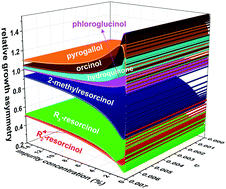Role of tailor-made additives in controlling vapour growth asymmetry along the polar axis of α-resorcinol crystals: a molecular-scale study†
Abstract
We report a mechanistic approach to study the effect of different tailor-made additives and conformers of resorcinol to elucidate the mechanism of unidirectional vapour growth of α-resorcinol crystals along the polar axis. Based on the kinetics of the growth process, we derived an expression for the rate of growth that eventually relates the kinetic and thermodynamic aspects of the adsorption of host and additive molecules on flat-faces of crystals. Ab initio periodic dispersion-corrected density functional theory using a hybrid exchange–correlation functional has been employed to obtain the adsorption energy landscape of the host molecule, different conformers of resorcinol and tailor-made auxiliaries to ascertain the role played by these auxiliaries towards understanding the growth anisotropy. Different step configurations along 2-D lattice vectors and molecular orientations have been examined before obtaining the adsorption energy of the host and tailor-made molecular auxiliaries. The results of our periodic density functional theory calculations show that the phenomenon of asymmetric growth of α-resorcinol occurs because of the conformational change which arises due to the surface stabilization of the slower growing face. The calculated vapour growth anisotropy of the faces at the opposite ends of the polar axis of α-resorcinol is in excellent agreement with the experimental observation. We find that the adsorption energies of the strongly bound additive moieties such as 2-methylresorcinol, 5-methylresorcinol, phloroglucinol and hydroquinone at the surface of the faster growing (0![[1 with combining macron]](https://www.rsc.org/images/entities/char_0031_0304.gif)
![[1 with combining macron]](https://www.rsc.org/images/entities/char_0031_0304.gif) ) face are higher than those of the slower growing (011) face. It is thus expected that vapour growth anisotropy decreased with an increase of the concentration of the aforementioned molecular auxiliaries. On the other hand, the admixture of β and γ-phase conformers of resorcinol and pyrogallol strongly interacts with the slower growing face and, therefore, addition of these auxiliaries would increase the growth anisotropy. The results show that the vapour growth asymmetry decreases with increasing saturation temperature of β and γ-phase conformers and pyrogallol deliberately added during crystallization. However, the admixture of 2-methylresorcinol, 5-methylresorcinol, phloroglucinol and hydroquinone would result in an increase of growth anisotropy with an increase of saturation temperature.
) face are higher than those of the slower growing (011) face. It is thus expected that vapour growth anisotropy decreased with an increase of the concentration of the aforementioned molecular auxiliaries. On the other hand, the admixture of β and γ-phase conformers of resorcinol and pyrogallol strongly interacts with the slower growing face and, therefore, addition of these auxiliaries would increase the growth anisotropy. The results show that the vapour growth asymmetry decreases with increasing saturation temperature of β and γ-phase conformers and pyrogallol deliberately added during crystallization. However, the admixture of 2-methylresorcinol, 5-methylresorcinol, phloroglucinol and hydroquinone would result in an increase of growth anisotropy with an increase of saturation temperature.



 Please wait while we load your content...
Please wait while we load your content...